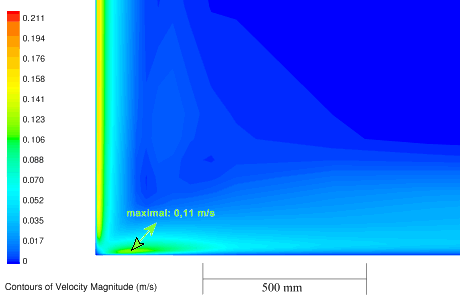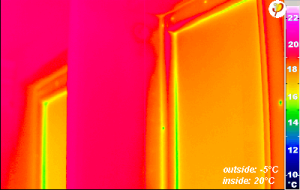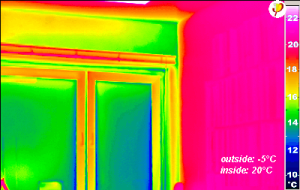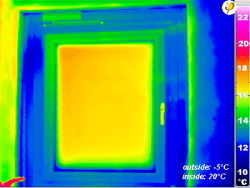Table of Contents
Local thermal comfort
It is interesting that all comfort criteria are automatically fulfilled in an optimum way with the requirements of the Passive House Standard - Improved thermal insulation simultaneously improves thermal comfort. This can be explained as follows:
- By improving thermal insulation (regardless of the external building component to which it is applied) the heat flow from the inside to the outside is reduced.
- Therefore the heat flow from the building’s interior to the internal surface of this external building component is also reduced. The heat flow overcomes the so-called thermal resistance of the surface (radiation and convection).
- The smaller heat flow results in a smaller temperature loss at this surface, in other words: the temperature difference between the inside (the surfaces in the room and the indoor air) and the interior surface of the component with improved insulation decreases.
The practical consequences are that with very well-insulated external building components, the temperature of the interior surfaces varies only slightly from the surrounding temperature in the room; this applies both in summer and winter. This means that the inner surfaces of the external components are pleasantly warm even in winter (external walls, roofs etc. not more than 1 °C below the indoor air temperature, window surfaces a maximum of 3 to 3.5 °C below this [Pfluger 2003] ). “Passive House quality”, particularly for windows, can even be defined as follows: the insulating effect of a window suitable for Passive Houses must be so efficient that even under the coldest design conditions,
θ area - θ surf ≤ 3.5 °C
still holds true. These small temperature differences have the following effects on all comfort criteria:
- Air speeds in the room (apart from leaks – which do not occur in the airtight Passive House anyway) are due to uplift at surfaces which have differing temperatures. Because of the small temperature differences the lifting forces are very small. As a result, air speeds also remain very small. Fig.1 shows a CFD (Computational Fluid Dynamic) simulation: even though there is a heater under the window, no draughts occur in the living area.
- The radiant temperature difference in various directions cannot exceed 3.5 °C if the external surface temperature is not more than 3.5 °C below the indoor temperature. The thermographic images in Fig.2 to Fig. 4 show the difference between windows with various insulation qualities.
- The indoor air temperature stratification between the head and ankles of a seated person is less than 2 °C - but only if the effective average U-value of the external building component is less than 0.85 W/(m²K). See. the illustration on the Thermal comfort parameters page.
- The perceived temperatures at various locations in the room differ by less than 0.8 °C.
All the comfort criteria have been ideally fulfilled, without the need for a compensating heating surface. That is why the Passive House room “automatically” has a radiant heat climate, regardless of how the heat is provided. Furthermore, as large temperature differences do not arise, there is also less air movement. The results presented here are documented in the publication [Pfluger 2003] .
Findings from three independent research projects have confirmed that these characteristics of well-insulated building envelopes can be observed in practice:
- Thermographic images, air temperature and air speed measurements in Passive Houses experimentally confirm the results presented here ([Schnieders 2002] ).
- Physiological measurements by Bernhard Lipp objectify the perception of comfort ([Lipp 2004] ).
- Sociological surveys of a representative number of residents gave high marks for well insulated buildings ([Hermelink 2004] ).
See also
Literature
[Pfluger 2003] Pfluger, R.; Schnieders, J.; Kaufmann, B.; Feist, W.: Hochwärmedämmende Fenstersysteme: Untersuchung und Optimierung im eingebauten Zustand (Anhang zu Teilbericht A), 2003, Internet Publication (in German)
(Highly insulating window systems: inspection and optimisation in the installed state, Appendix to Sub-report A)
[Schnieders 2002] Schnieders, J.; Betschart, W.; Feist, W.: Raumluftströmungen im Passivhaus: Messung und Simulation HLH 03-2002, Seite 61
(Indoor air flows in the Passive House: measurement and simulation HLH 03-2002, page 61;
Abbreviated online version in German: Residents' experience)
[Lipp 2004] Lipp, B. und Moser, M.: Heizsysteme und Behaglichkeit: Ist Behaglichkeit physiologisch messbar? in: AkkP Protokollband Nr. 25, Darmstadt, 2004
(Heating systems and comfort: is comfort physiologically measureable?, in Protocol Volume No. 25, Darmstadt 2004; Abbreviated online version in German: Thermal comfort)
[Hermelink 2004] Hermelink, Andreas: Werden Wünsche wahr? Temperaturen in Passivhäusern für Mieter; in: AkkP Protokollband Nr. 25, Darmstadt, 2004
(Can dreams come true?: Temperatures in Passive Houses for tenants, in Protocol Volume No. 25, Darmstadt, 2004; Abbreviated online version in German: Residents' interview)




